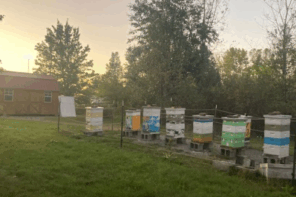All My Fault
Ed Colby
It’s a snowy 3 a.m. on May 4 here in western Colorado. Can’t sleep. My head is filled with honey bee dreams, the worrying kind.
I had something of a bad day with the bees yesterday in Palisade. At one location all was well. But at the other my 16 colonies looked pathetic. They were making honey two weeks ago, when I pulled nucs from the strong ones. Yesterday nearly all of them had a severely diminished numbers of bees. Most had ample food stores, but they’d made little if any new honey. Some of the brood looked spotty. I did sugar shake tests on four colonies and couldn’t find a Varroa mite.
There were no dead bees on the ground outside the hive entrances, but I suspected pesticides nonetheless.
I hauled these bees 65 miles down the road to Palisade in late March for the apricots and plums and sweet cherries. Palisade is famous for its peaches, but most varieties are self-fertile and don’t require a pollinator. I used to have four pollination customers in the vicinity, but one in nearby Grand Junction lost his cherry trees to a freak October 2020 freeze. The mercury dropped to single digits while the trees were still in full leaf. By Spring, they were mostly dead. So he doesn’t need my bees anymore.
A gentleman who’s hired me for 20 years for apricots called at the last minute to cancel. The blossoms came five days sooner than he had predicted. He did warn me to come early, just in case, but I couldn’t make it. There were only two days of full bloom combined with good bee weather before weather moved in, and I missed it. Mea culpa! Fortunately for the grower, there were 200 commercial colonies a couple of miles down the road. So he’ll probably do all right.
What I’ve done before is fetch my Palisade bees as soon as the bloom is finished, so as to avoid the pesticide applications that begin in earnest at peach petal-fall, when dandelions are still in bloom. A commercial guy told me years ago that his Palisade bees “just don’t build up right,” and he blamed insecticides. I took this to heart. “Get ‘em in, get ‘em out!” has been my strategy ever since, until now. They’d spend three weeks or so in the orchards and usually come home stronger than I sent them.
But this year I talked to another migratory beekeeper, who also drops off bees to Palisade in the Spring on their way home from the California almonds. He sometimes leaves them deep into May, until the dandelions raise their golden heads on their Summer pastures on higher ground. He said he had pretty good luck doing that.
You see, here in Colorado, climate is elevation-sensitive. As you go higher, it’s like heading north. Dandelions bloom in Palisade at 4700 feet in early to mid-April. As you come up the Colorado River and Roaring Fork valleys, they flower in New Castle at 5500 feet in late April, then in early May in Carbondale at 6200 feet, finally reaching Aspen at 7900 feet in late May and heading up into the high mountain valleys in June. If things go just right, I can give my bees two or even three helpings of their favorite Spring flowers, as I move the little darlings to higher ground.
I had a choice with my 20 hives in Palisade. I could pull them in April while the dandelions were still in full bloom – like I always have – or I could take my chances with the spraying and leave them be until an opportune moment to move them to a Summer yard at higher elevation. I opted for the latter and evidently paid the price.
For beekeepers, the prudent path isn’t always obvious. Pesticides can be harmful, sure, but so can starvation. I try to never move bees if they’re making honey. Cool Spring weather or wind or rain or snow will shut off a honey flow, and if bees fail to make honey on dandelions, they can eat up all their honey. Of course I can feed them sugar or corn syrup, but I hate to do it. It costs time and money, and it gets my fingers all sticky.
On my way home from Palisade, as I came down off East Orchard Mesa, on an impulse I took the meandering road through the Vinelands that runs close to the Colorado River and roughly parallels U.S. Highway 6. Spring frost is always problematic for Palisade growers, but the Vinelands are considered a choice location, since downstream winds coming out of Debeque Canyon can blow out the cold air that naturally collects along the river bottom.
I was driving along minding my own business when I took a wrong turn. Suddenly the road ended, and I found myself heading into somebody’s driveway. A crudely painted sign read, “If your G.P.S. got you here, my G.U.N. will make you leave!” This didn’t strike me as very neighborly, but I was more than anxious to oblige.
OK, it’s still 3 a.m., but it’s a different morning. I just don’t sleep in the wee hours anymore. I got a hot report on the dandelions at a yard up the road. I just need to re-build the solar-electric bear fence before I haul those sick Palisade bees up there.
I can’t prove they got hit by pesticides, but I do know one thing: If they don’t make it, it’ll be my fault.









